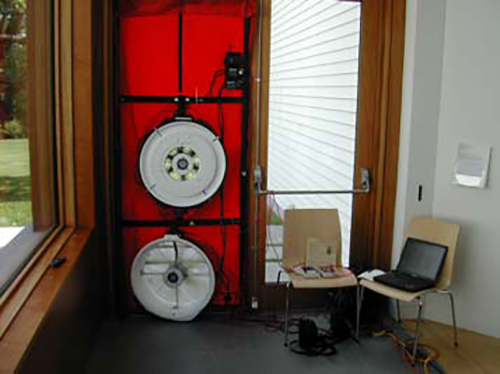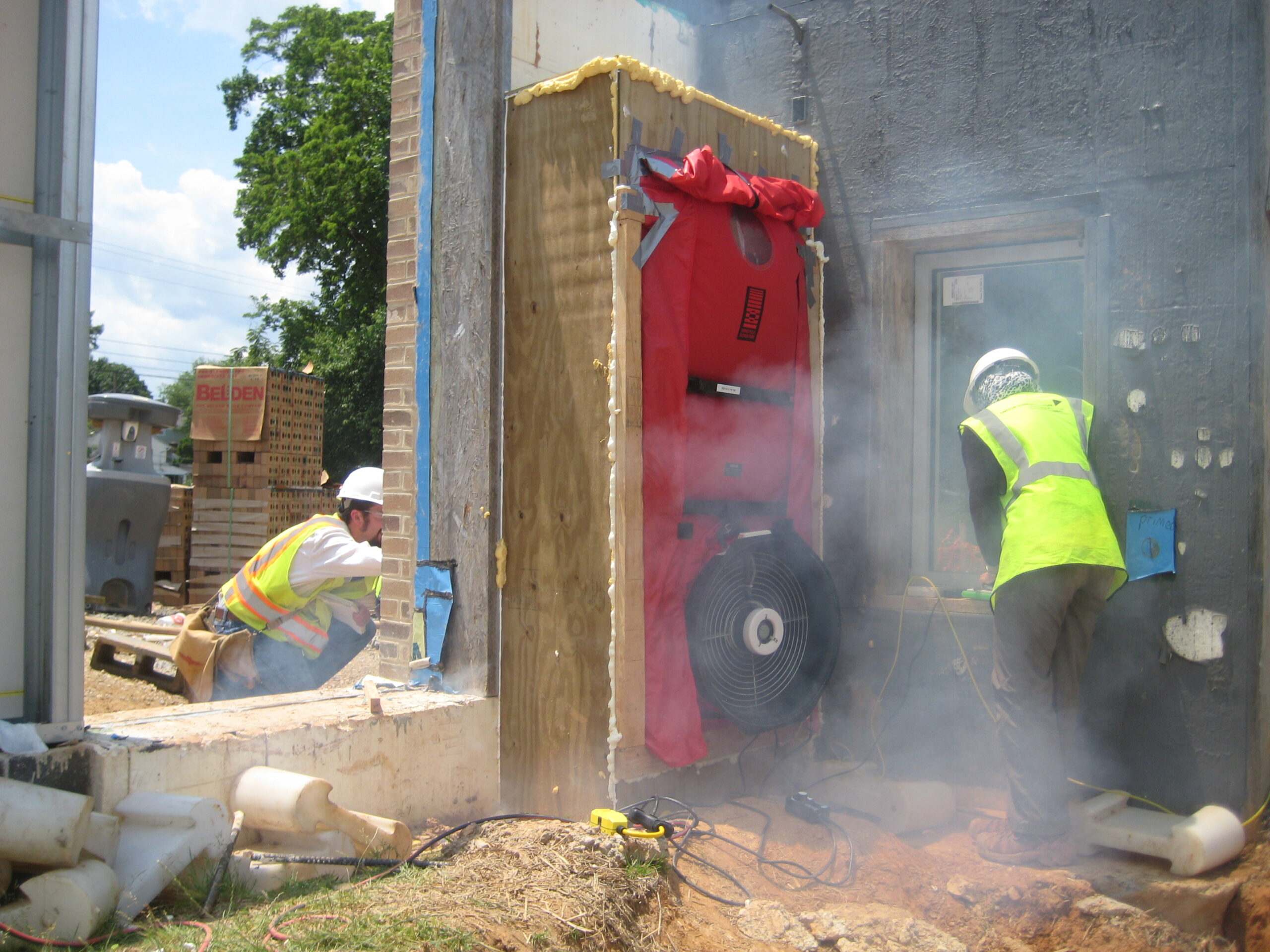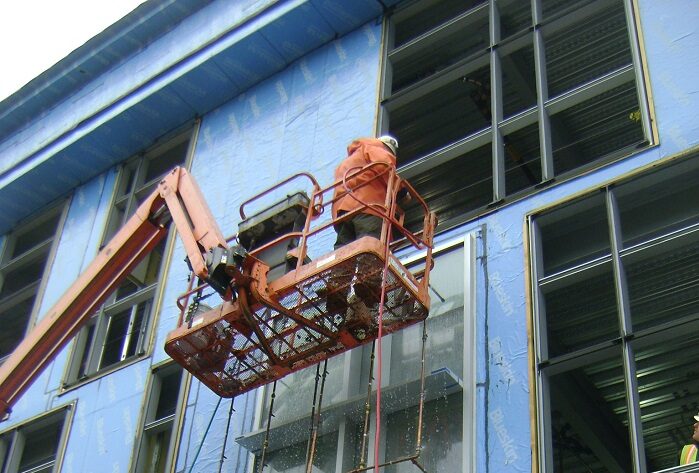This resource is available courtesy of DCSEU.

The building envelope is one of the largest and most crucial systems that affect a building’s energy performance and its levels of occupant comfort. When the District of Columbia adopted new construction codes in early 2020, it included provisions (DCMR 12I, §11.3.1.3) that require building envelope system design review and testing. That requirement, called Building Envelope Commissioning (BECx), is a quality assurance process for verifying the owner’s requirements for the building enclosure are defined and met. As envelope systems become more and more complex alongside new requirements for increased building performance, building envelope commissioning will be a fundamentally important process to ensure quality. This resource intends to help owners, architects, other design professionals, and general contractors understand the District’s code requirements related to BECx and plan for incorporating the approach into the design and construction process within the District.
Jump ahead
BECx information for owners
BECx information for practitioners
The 2017 DC Construction Codes, adopted in 2020, introduce requirements for conducting whole-building airtightness testing or commissioning of the air barrier construction. These requirements intend to improve the performance of newly constructed exterior wall systems through increased documentation, validation, and verification. BECx is intended to increase the likelihood that completed construction meets the owner’s requirements through review of the air barrier design and installation.
Air barrier systems are complex and must be designed and constructed to comply with many competing performance criteria. The BECx Authority, a third-party commissioning agent, acts as an independent party to develop and manage the BECx process, and provides technical advice pertaining to the air barrier. Specific to the DC Energy Conservation Code objectives, BECx aims to decrease the likelihood of poorly performing air barrier assemblies. The code and relevant industry standards establish objectives and procedures for the project team through project completion.
During the design phase, BECx validates that contract documents reflect the owner’s requirements. During bid, construction, and occupancy and operations, the BECx process verifies the design is properly implemented to comply with such requirements.
The DC Code includes two compliance paths for its BECx requirement: Whole-building airtightness testing or working with a qualified air-barrier Building Envelope Commissioning Authority (BECxA).
Compliance option 1: whole-building airtightness testing
A whole-building air tightness test (DCMR 12I, §11.3.1.3.a) entails a single test (or a sampling of tenant units in multifamily buildings) to validate the air leakage rate of the completed air barrier assembly complies with the code criteria. Since a building’s air barrier relies on continuity across several systems (e.g., fenestration, wall membranes, roofs, etc.) the test must occur relatively late in the building enclosure installation process.
In contrast to the second BECxA compliance path, whole-building air tightness testing provides direct validation of performance and a clear and quantifiable metric for success. However, since the testing occurs late in the construction process, repairs could be costly and difficult to address if a test fails. Additionally, this type of test does not address the thermal continuity, water barrier, and other performance criteria vital to enclosure performance.

Photo courtesy of Simpson Gumpertz & Heger
Airtightness testing involves temporarily sealing mechanical openings (louvers, flues, etc.), erecting blower door fans, pressurizing the building (or portion thereof) interior, and measuring the air flow rate.

Photo courtesy of Simpson Gumpertz & Heger
Smoke testing is one common option to identify leakage and involves pressurizing the building interior (or portion thereof) and applying tracer smoke to visually identify the air flow. Other options include infrared thermography and exploratory openings.
Compliance option 2: air barrier building envelope commissioning authority (BECXA)
The BECxA compliance option (DCMR 12I, §11.3.1.3.b) incorporates a qualified commissioning authority into the project lifecycle (design and construction phases) to enhance the quality assurance of the air barrier through documentation, validation, and verification. This compliance option is most akin to the commissioning process common to MEP systems.
Major tasks for successful BECxA
All quotes in this section reference ASTM E2947-12: Standard Guide for Building Enclosure Commissioning unless otherwise noted.
Legend |
|
| Task explicitly included in §11.3.1.2, Commissioning Process, for review of the air, water, and thermal barriers | |
| Task explicitly included in §11.3.1.3, BECxA, for review of the air barrier | |
| Task explicitly included in §11.3.1.3, Whole Building Air Testing |
Documentation
BECxA aims to document the decision-making process to encourage the project team to plan the BECx procedures, make the ground rules readily available to all parties, increase accountability for the decision-making process, and benchmark success. All documents are subject to change as the project evolves.
| Owners project requirements (OPR)
|
“Includes the programmatic, aesthetic, and functional performance requirements of a building or structure and the expectations of the owner relative to its intended use, occupancy, operation, and service-life.” (ASTM E2813, Annex A1) |
| BECx plan
|
“Outlines the organization, schedule, and allocation of resources, responsibilities, and documentation requirements of the whole-building commissioning process.” |
| BECx specification
|
“Outline[s] the testing and inspection scopes and the roles and responsibilities” and incorporates the process into the contract. |
| BECx report
|
Often the final update to the BECx plan and memorializes the completed process and indicates any outstanding issues. |
Design validation
BECxA reviews the design “to validate that the Architect’s BOD document responds to and reflects the OPR and verifies that the plans and specifications developed throughout the design phase are consistent with the OPR.”
| Design reviews
|
· One design review as a requirement for the air barrier.
· Two design reviews for the air, water, and thermal barrier. |
Verification
BECxA verifies that the Contractor understands and intends to implement systems that meet the OPR and design documents.
| Review bids | “Review the BECx process with the prospective bidders and are involved in the technical evaluation of contractor/ subcontractor proposals. The BECxA reviews technical proposals and assists with the technical evaluation of bids.” |
| Submittal review | “Technical reviews of building enclosure submittals including shop drawings for compliance with the construction documents and the OPR.” |
| Inspections (i.e., site visits)*
|
“Periodic… visits to review the fabrication, assembly and installation of the building enclosure components and systems. The purpose of these visits is to verify that what was observed is in compliance with the approved documents, to monitor the contractor’s QA/QC efforts…, and to assess workmanship, functional installation, and material/assembly performance…” |
| Testing
|
Witness (or self-perform) the specified performance verification testing, issue a formal test report, and document observed investigative and remediation steps. |
| Occupancy review | On-site meet “with the Owner and their property management and building engineering representatives… to discuss any problems encountered in operation, tenant complaints… and any in-service changes that have occurred to the building since substantial completion.” |
Compliance option comparison
Compared to the whole-building airtightness testing compliance path, pros of BECxA are that it:
- identifies detailing and system selection issues during design phase when cost impacts can be more easily managed.
- identifies issues early in the installation process to limit extent of necessary rework.
- provides increased documentation to enhance communication and accountability throughout the project.
- is relatively easily augmented to include review of other enclosure performance criteria.
However, using this compliance path does not produce a quantifiable metric for success and may be less cost efficient for small or more straight-forward project designs.

Photo courtesy of Simpson Gumpertz & Heger
A critical component of air barrier BECx includes periodic site visits to observe the ongoing construction for compliance with the contract.
BECX information for owners
Owner’s project requirements
“The OPR is a written document that includes the programmatic, aesthetic, and functional performance requirements of a building or structure and the expectations of the Owner relative to its intended use, occupancy, operation, and service life.” The owner typically writes the OPR with the assistance of the BECxA and architect. Alternatively, the BECxA may develop the OPR with substantial input from the owner. Many owners with a portfolio of buildings establish a standard OPR or “Design Guidelines” document that is then updated for each project. The OPR should set the expectations for the many performance categories, including: moisture, condensation, heat flow, air flow, energy, structural, durability, resiliency, reliability, and sustainability.
Below are examples of the types of questions that the OPR can answer:
- Are we aiming to meet code minimum energy performance or something more stringent?
- Is the project aiming for any green building certification?
- Do the windows need meet a minimum performance?
- Does the owner’s facilities team have material or manufacturer preferences?
- What is the desired life expectancy of the building and/or specific systems?
Engaging an air leakage testing agency
An owner should engage an air leakage testing agency during the construction phase, preferable before cladding installation. In contrast to BECxA, a specific contractual relationship is not specified in the code.
Owners should consider the following when developing requests for proposals:
- How will the test best be incorporated into the construction schedule?
- Will dividing the enclosure into multiple zone tests help the schedule and/or resolve issues early?
- Are the contract documents clear on how a failure is resolved? Are the responsible subcontractors aware of this?
- Should the testing agency help identify specific air leakage sources if a failure occurs? If so, is the testing agency experienced with enclosure design and construction?
Engaging a BECxA
A BECxA should be engaged early in the design process, preferably before completion of schematic design. The DC Code explicitly states (DCMR 12I, §11.3.1.2.1.a) the owner shall engage the commissioning team directly. Field-testing agencies may be hired by the owner, contractor, or be self-performed by the BECxA.
“Core competencies” that a qualified BECxA should have based on previous project experience include building and material science; procurement and project delivery; contract documents and administration; and performance test standards and methodology.
Owners should consider the following when developing requests for proposals:
- Is this an existing building that warrants an assessment of the existing enclosure to determine methods for BEPS compliance?
- Is the objective limited to the air leakage testing compliance path only?
- Does the complexity or critical operations of the project warrant scope beyond minimum code requirements? If so, which standard is being followed, if any?
- Is the project also pursuing LEED or a similar certification system? If so, are enhanced Cx credits being pursued?
- Is the BECxA conducting any testing? Is it more appropriate to determine testing scope at end of the design?
- What is the frequency of site visits?
BECx information for practitioners
Responsibilities
“The Commissioning Process assumes that owners, programmers, designers, contractors, and operations and maintenance entities are fully accountable for the quality of their work.”
- Architect-of-Record: Retains responsibility for the design and implementing BECxA comments as appropriate and directed by the Owner.
- Contractor: Retains responsibility for the Work, implementation of the Contract Documents, and quality control.
- BECxA: Retains responsibility for providing technical advice regarding enclosure performance and “should be able to demonstrate and maintain throughout the project third party independence in order to avoid conflicts of interest.”
The BECxA is responsible for recommending an appropriate regimen of performance testing, but the Architect is responsible incorporating these recommendations into the Design as they see fit and as directed by the owner.

Photo courtesy of Simpson Gumpertz & Heger
Alternative compliance paths for commercial building projects
In lieu of complying with the DCMR 12I Energy Conservation Code – Commercial Provisions, commercial building projects may comply with an alternative compliance path (DCMR 12A §101.10.6):
- DCMR 12I, Appendix Z – Net-Zero Energy Compliance Path (incorporates requirements for BECx and whole building air tightness testing.)
- The International Living Future Institutes (ILFI): Living Building Challenge or Zero Energy Certification
- Passive House Institute United States (PHIUS): PHIUS+ or PHI and On-Site Solar (incorporates many similar tasks as BECx)
- Leadership in Energy and Environmental Design (LEED): LEED certified and LEED Zero Energy (includes requirements for enhanced commissioning).

